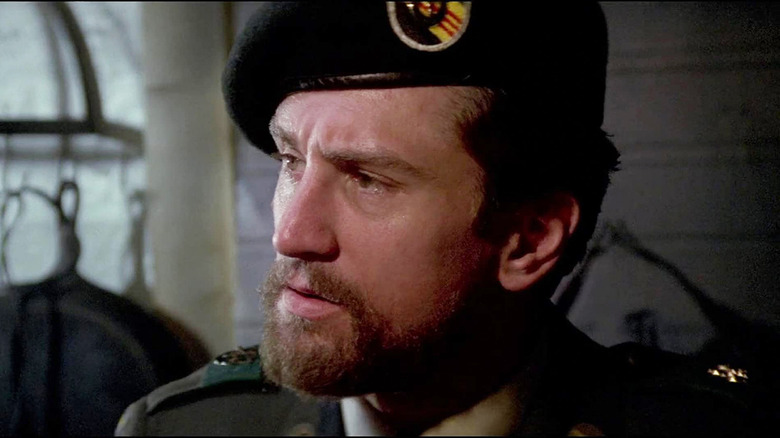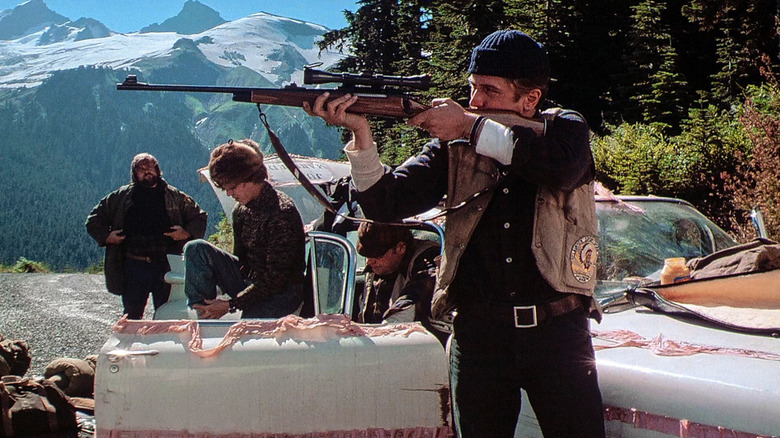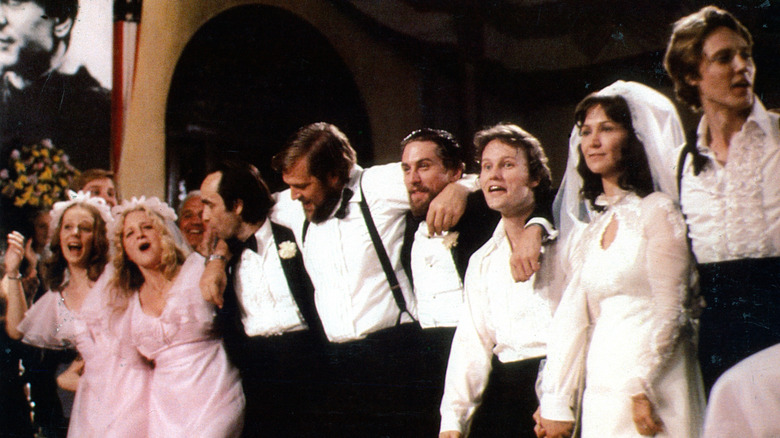Why Robert De Niro Needed A Deeper Look Into The Deer Hunter Before Fully Committing
Robert De Niro is known for his dedicated Method style of acting, where having authentic experiences that match your characters' lives enhances your performance. De Niro drove taxi cabs around New York City to prepare for "Taxi Driver," learned saxophone for "New York, New York," and ate tons of Italian pasta to gain weight for "Raging Bull." Before signing up to star in 1978's "The Deer Hunter," De Niro accompanied director Michael Cimino on a tour of the filming locations. Pennsylvania, Ohio, and Washington would form and inspire the film's blue-collar setting of Clairton, Pennsylvania.
Speaking to GQ for its oral history about the making of "The Deer Hunter" in 2019, De Niro explained he felt "soaking up the environment" of his character Michael — a steel mill worker turned traumatized Vietnam veteran — would make his performance more rich. The actor "tried to become as close to becoming a steelworker as possible without actually working a shift at the mill. I'd have done that too, except none of the steel mills would let me do it. They let me visit and watch but not actually get involved."
By meeting other steelworkers, De Niro got a better understanding of Michael's habits, speech patterns, and working-class lifestyle. These qualities would inform his nuanced performance. As Michael, De Niro has a pensiveness that is nearly impossible to penetrate. His quiet nature masks his internal pain, reflecting the tough masculinity of his community's culture.
Home is one of the most important themes of "The Deer Hunter." The film depicts a very specific way of living that De Niro pinpoints in his performance. The cultural behaviors and attitudes of the working-class, Northeastern setting adds resonance to the story of three friends returning home after the horrors of the Vietnam War.
Finding home again
Michael Cimino told GQ, "I would never suggest that the geography or visual environment of the film is more important than what's going on with the people, but it's a major factor in getting the right tone." Robert De Niro understood that a sense of place was crucial to "The Deer Hunter," and actually going to the locations would be an integral part of preparing for his role. The Pennsylvania setting is the heart of "The Deer Hunter." It is what anchors the characters' understanding of their post-war trauma.
In the film, Michael, Steven (John Savage), and Nick (Christopher Walken) belong to a very patriotic and close-knit Russian Orthodox community that supports them going to fight in the Vietnam War. The men believe it will be no different than their favorite sport of deer hunting, which requires careful calculation and control to annihilate your target. However, the controversial Russian roulette scenes reveal that war is a chaotic, traumatizing nightmare.
When Michael and Steven return home, they are unable to share their horrific wartime experiences with friends and family: Michael resists the community's perception of him as a hero and Steven loses his legs and refuses to see his wife. Nick, on the other hand, descends into Saigon's gambling underworld. These types of working-class young men were the backbone of the Vietnam War. By immersing us in the particulars of their quiet hometown, the audience gains a deeper understanding and empathy for them and the war's devastation.
The wedding scene
One of the ways Michael Cimino establishes the distinct milieu of "The Deer Hunter" is through the hour-long wedding sequence at the beginning of the film. Tons of family and friends — humble, blue-collar people who work at local stores or factories — gather to celebrate Steven's marriage and their hometown heroes before they head off to war. The scene overflows with dancing, laughter, flirtations, and kinship. Seeing the intimacy of the men's relationships with everyone in the town makes their inability to connect after the war even more devastating; post-war trauma affects not only soldiers, but entire communities.
Cimino abruptly cuts from the joyous party to the hot, sticky Vietnam where Michael, Steven, and Nick could die at any moment. The juxtaposition between the loving embrace of their community and the harsh violence of war is shocking. The trio longs for the familiarity of home, away from the anarchy of war. Although their hometown has small, cramped homes in the middle of the woods and the cold, harsh industry of steel mills, it brings them peace because it is all they have ever known.
My husband is from a similar coal mining town in Pennsylvania, and I can attest that "The Deer Hunter" accurately captures that lifestyle. It is also a working-class community where multiple generations live, enjoy deer hunting, and many young men pursue the military. Celebrations often look like the opening scene of "The Deer Hunter": teeming with people who are all connected in some way. Friends are like family, and big families live in close proximity. I can understand why Robert De Niro needed to see how the environment his character grew up in. Those types of blue-collar towns have a very unique way of living and relating to others.


